Rating the Biden Administration’s First 100 Days
Expectations were high for the Biden administration, which had set itself the goal of restoring U.S. leadership and partnership. The first few months of an administration can tell us little about final outcomes, but much about a president’s priorities, productiveness, and leadership style. Eleven analysts from GMF review how the administration performed in its first 100 days on key transatlantic issues.
The first is the policy approach. Has the policy been coherent, clear, consistent? And is it smart; is it the right approach? And the second rating is for cooperation, believing as we do in the advantages of alliances and partnerships. Has the policy been collaborative, in cooperation with partners? For each rubric we offer a rating of excel, pass, or fail.
The Overview
On China policy, the Biden administration gets a gets a pass for smart policy/ and an excel for cooperation.
On climate and energy, the administration has made great strides quickly and gets an excel/excel scoring.
On transatlantic security, the first signs are positive, but it is too early to judge whether the approach will yield results, so Biden and his team get a pass/pass.
On Mediterranean issues we focus in on two specific points: the Iran nuclear deal and relations with Turkey. On both issues the administration’s careful and pragmatic approach is deemed smart but not yet excellent, and well-coordinated, so a pass/excel.
On tech policy, Biden’s early moves have been strong and significant, combining the right rhetoric with big investments. Here the administration gets an excel/excel rating.
On economic policy, the president has launched a bold plan to remake the U.S. welfare state, with global implications. For coherence and clever vision, the policy gets excellent marks, for coordination it is a pass until we see whether trade relations improve.
China Policy: The Biden Administration Gets a Pass
The Biden team had long signaled that it would take a firm position on China. Some have referred to it as similar to the Trump administration’s tough line, but “more strategic, more multi-lateral and more effective.” Though the focus lies on competition with an increasingly assertive China, the administration also wants to cooperate with the country on issues such as health, climate change, and arms control (according to the Interim National Security Strategy). In fact, the administrations “compete and cooperate” rhetoric is somewhat reminiscent of the EU’s assessment of China as partner-competitor-rival—a designation that has come under scrutiny inside and outside of Europe as an excuse for the EU to avoid a tougher policy on China.
Like all other aspects of U.S. foreign policy, China policy is still undergoing a review. This includes the various measures put in place by the Trump administration, including the Phase 1 Trade Deal. The Biden administration is likely to face pressure from those who want a tougher policy as well as from those still hoping for a “reset” of relations with China. While much remains open at this point, some trends are emerging.
Coherent, Smart, Coordinated?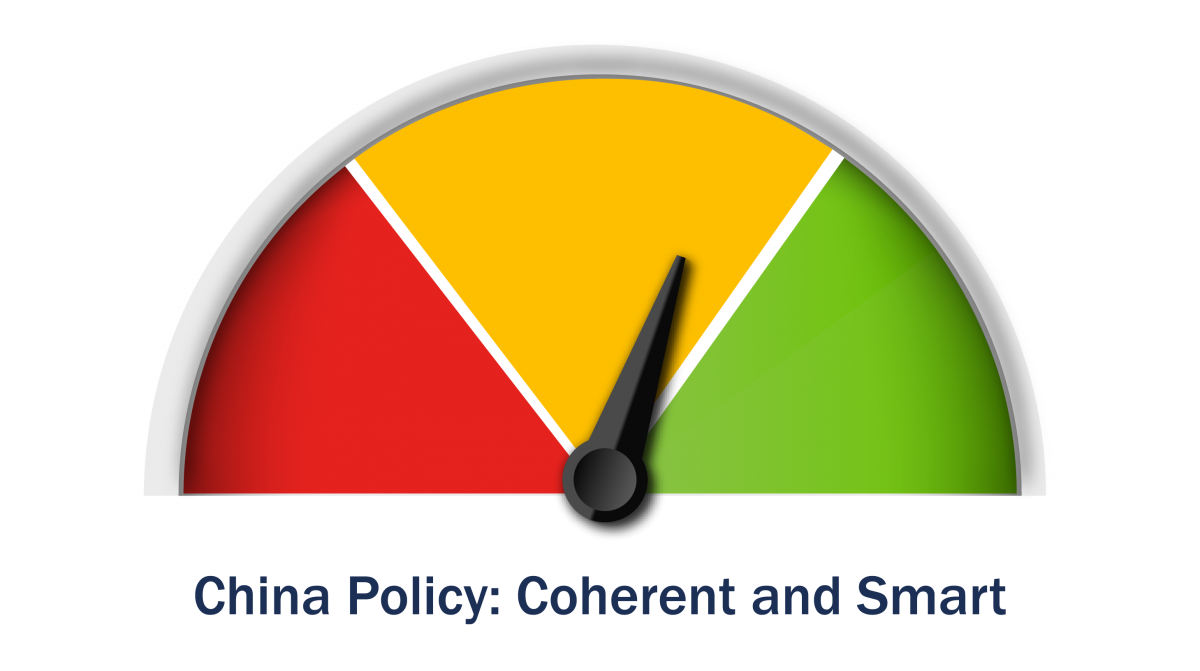
First, let us focus on what has gone right. Biden has brought together an impressive team of people who have a clear understanding of China and the challenges it poses to the United States. The administration has reversed its predecessor’s retreat from multilateralism, which had provided China the opportunity to fill the vacuum left by the Unites States and expand its influence over international organizations.
Then there were blunders like the Anchorage meeting, where the administration seems to have been caught off guard by its Chinese interlocutors going into wolf-warrior mode. Much of this posturing was directed toward a Chinese audience, but it would be a mistake to ignore the bigger global context. In the wake of the coronavirus pandemic, China’s government has assessed that the global balance of power has shifted in the country’s favor, and thus it now needs to act accordingly. Anchorage gave a taste of what that will look like. Under these circumstances, the Biden administration, just like the EU and others, will need to ask itself how much compartmentalization will be possible in its China policy. Can the United States cooperate with China on climate on Monday and compete on technology on Tuesday?
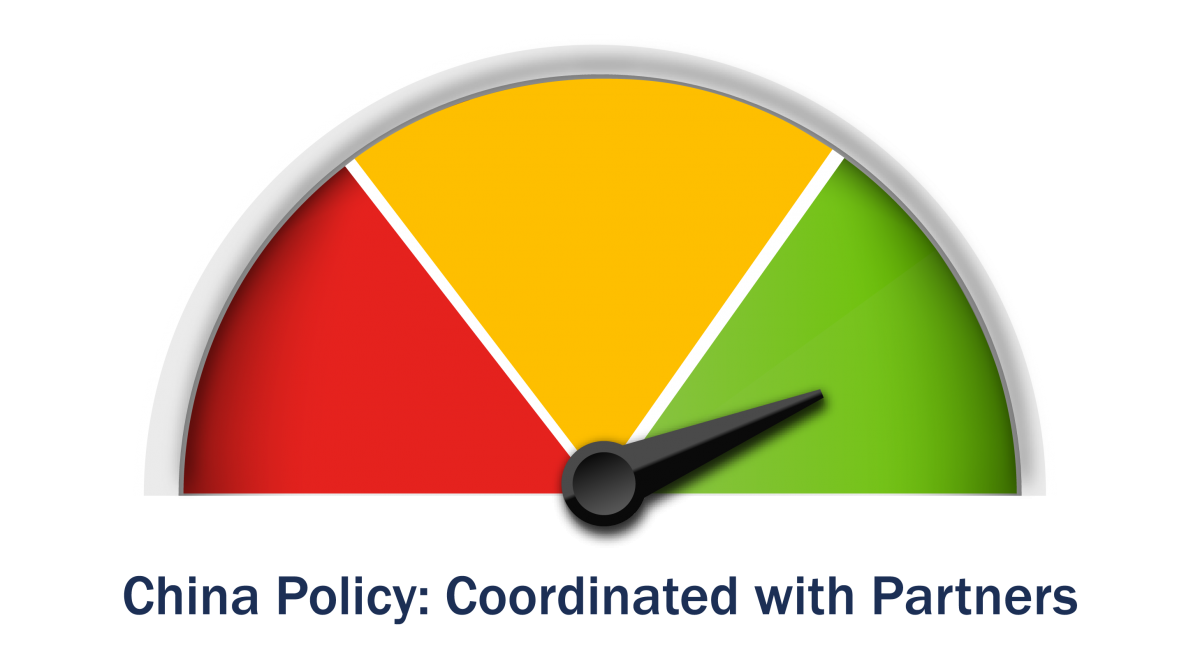 The United States has also coordinated with the EU, the United Kingdom, and Canada on sanctions—announced last month—on Chinese officials and entities for human rights violations in Xinjiang. Though largely symbolic, this was a step in the right direction, and the fact that China retaliated disproportionately shows how important it is for the Chinese government to prevent such coordinated action. During his visit to Brussels Secretary of State Antony Blinken revived the U.S.-EU Dialogue on China, originally proposed by the EU to the Trump administration. This is another step in the right direction, though much will depend on how the dialogue will work in practice.
The United States has also coordinated with the EU, the United Kingdom, and Canada on sanctions—announced last month—on Chinese officials and entities for human rights violations in Xinjiang. Though largely symbolic, this was a step in the right direction, and the fact that China retaliated disproportionately shows how important it is for the Chinese government to prevent such coordinated action. During his visit to Brussels Secretary of State Antony Blinken revived the U.S.-EU Dialogue on China, originally proposed by the EU to the Trump administration. This is another step in the right direction, though much will depend on how the dialogue will work in practice.
What to Watch
To gauge the direction of China policy and how much flak the Biden administration will be willing to take from U.S. stakeholders opposed to a tougher line, I will be watching whether it will go ahead and delist Chinese companies that do not comply with audit requirements from U.S. stock exchanges, which are almost all of them, as some are predicting and as a law signed by Trump requires.
Climate and Energy: Quick and Strong Out of the Gate
Laura Basagni and Megan Richards
Joe Biden’s campaign promised a plan for a clean-energy revolution and environmental justice that will make the United States a net-zero economy by 2050 as well as leading globally in clean-technology production and export. In stark contrast with the previous administration, this one has endorsed scientific positions on climate change and has said that “the way we act—or fail to act—over the next decade will determine the livability of our planet.” Biden’s climate plan promises to invest $1.7 trillion over ten years in research, development, and zero-carbon technology; to create 10 million good-paying jobs in the clean-energy sector across the country; and to do justice to communities that have been worst hit by polluting business practices. Biden also wants to restore U.S. leadership in the global fight against climate change: Shortly before the start of the ongoing climate summit, Biden announced the U.S. new target of halving greenhouse emissions by 2030, sending an important signal to the international community and challenging other countries to follow the same path.
Coherent, Smart, Coordinated?
 In this sector the Biden administration has passed the test of its first 100 days as it quickly began to deliver on its promises. The United States rejoined the Paris Climate Agreement promptly and the newly created special envoy for climate, John Kerry, began international diplomatic outreach immediately, including with a view to preparing the international leaders’ climate summit on 22 April. During his first weeks in office, Biden signed significant executive orders that stop new subsidies to fossil-fuel companies and new permits for oil and gas drilling on federal land and water. Two bills with large implications for climate policies have been introduced: the $1.9 trillion Covid-19 Relief Bill, which was signed into law last month, and the $2 trillion infrastructure plan. The Relief Bill includes about $35 billion in incentives for electric vehicles and investments in electric grid, clean energy, and energy efficiency. The infrastructure initiative includes investment in a vast range of physical infrastructures and research and development programs, as well as $16 billion to support the retraining and transition of millions of workers to the green economy.
In this sector the Biden administration has passed the test of its first 100 days as it quickly began to deliver on its promises. The United States rejoined the Paris Climate Agreement promptly and the newly created special envoy for climate, John Kerry, began international diplomatic outreach immediately, including with a view to preparing the international leaders’ climate summit on 22 April. During his first weeks in office, Biden signed significant executive orders that stop new subsidies to fossil-fuel companies and new permits for oil and gas drilling on federal land and water. Two bills with large implications for climate policies have been introduced: the $1.9 trillion Covid-19 Relief Bill, which was signed into law last month, and the $2 trillion infrastructure plan. The Relief Bill includes about $35 billion in incentives for electric vehicles and investments in electric grid, clean energy, and energy efficiency. The infrastructure initiative includes investment in a vast range of physical infrastructures and research and development programs, as well as $16 billion to support the retraining and transition of millions of workers to the green economy.
 The administration’s climate plan is clearly aligned with the European Green Deal, and there are many areas where the transatlantic allies can cooperate. The EU has approved the creation of a Just Transition Fund to support its own communities phasing out of fossil fuel, of very similar magnitude (€ 17.5 billion) and scope to the plan proposed by President Biden. His proposal to demand a worldwide ban on fossil-fuel subsidies will find support among European allies: The European Investment Bank has pledged to stop financing fossil-fuel energy projects by the end of this year. The EU’s Emission Trading Scheme should be a useful reference point as the United States moves to implement a federal price on carbon, paving the way for necessary transatlantic cooperation in setting carbon border adjustment mechanisms in the future. Finally, European allies have rejoiced at the U.S. decision to rejoin the Paris Agreement. Both sides have expressed the commitment to working together at the international level and on pressuring China to end its practice of investing in polluting, fossil-fuel projects in third countries.
The administration’s climate plan is clearly aligned with the European Green Deal, and there are many areas where the transatlantic allies can cooperate. The EU has approved the creation of a Just Transition Fund to support its own communities phasing out of fossil fuel, of very similar magnitude (€ 17.5 billion) and scope to the plan proposed by President Biden. His proposal to demand a worldwide ban on fossil-fuel subsidies will find support among European allies: The European Investment Bank has pledged to stop financing fossil-fuel energy projects by the end of this year. The EU’s Emission Trading Scheme should be a useful reference point as the United States moves to implement a federal price on carbon, paving the way for necessary transatlantic cooperation in setting carbon border adjustment mechanisms in the future. Finally, European allies have rejoiced at the U.S. decision to rejoin the Paris Agreement. Both sides have expressed the commitment to working together at the international level and on pressuring China to end its practice of investing in polluting, fossil-fuel projects in third countries.
What to Watch
Biden’s biggest challenge is likely to be domestic as his priority should and will be to create national consensus around his ambitious climate plan. The first step will be to push the infrastructure investment plan through Congress without drastically weakening it. Second, the finances will have to be settled. The identified sources of finance—a reformed policy on subsidies and higher corporate taxes—will be crucial to deliver on environmental justice.
Transatlantic Security: Promising First Steps
Michal Baranowski, Alexandra de Hoop Scheffer, Martin Quencez
Since Joe Biden’s inauguration, his administration has aimed at repairing and reforming the transatlantic security and defense partnership.
The first goal has been to fix the damages done by the Trump administration, especially rebuilding European trust by reaffirming U.S. security guarantees and commitment to transatlantic security cooperation. This has been made very clear by the change in rhetoric and the positive signals sent by President Biden, Secretary of State Antony Blinken, and Secretary of Defense Lloyd Austin over the past three months.
The reform agenda has only started to become more concrete, with a focus on adapting the transatlantic security partnership to new issues—climate and disruptive technologies in particular—while recalibrating the alliance to the context of the U.S.-Chinese competition. To achieve this goal, the administration has already reinvested in NATO as the key platform for transatlantic security dialogue and aims to deepen U.S.-EU security and defense relations, as well as ad hoc and bilateral formats of cooperation.
Beyond the reassuring rhetoric, the Biden administration has communicated high expectations of its European allies, in terms of their ability to assume more security responsibilities in Europe and its direct neighborhoods, but also regarding a rethink of some of the tenets of relations with China and Russia relationships. The United States has invited Europe to join it in a struggle between democracies and authoritarian regimes at what is described as “a historical inflection point.” This will require the transatlantic alliance to adapt to these new geopolitical and ideological frameworks.
Coherent, Smart, Coordinated?
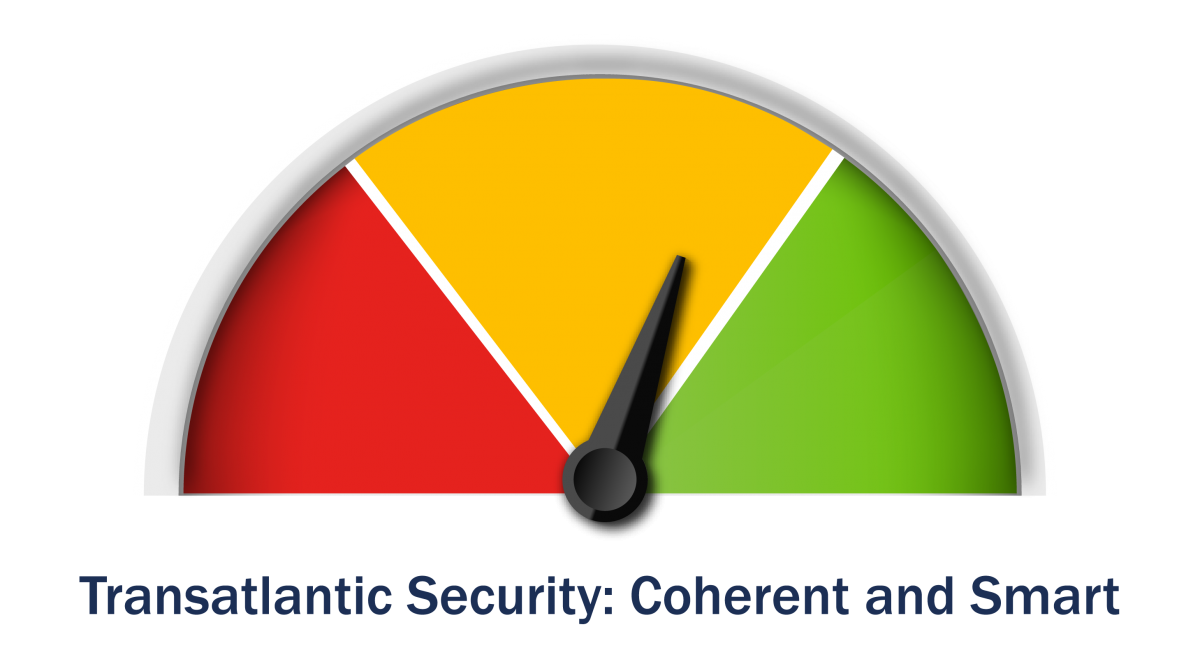 The Biden administration has been successful in projecting a reassuring and more engaged image to its European partners. The nominations of well-known transatlanticists to key positions, as well as the first declarations and contacts between heads of state, have conveyed the idea that a more predictable diplomacy will frame transatlantic security relations during Biden’s presidency. This has reduced the toxicity of the defense spending debate in Europe and created a new momentum for defense cooperation with the United States. The addition of 500 additional permanent troops in Germany is a concrete sign of U.S. recommitment to European security in a context of heightened tensions with Russia.
The Biden administration has been successful in projecting a reassuring and more engaged image to its European partners. The nominations of well-known transatlanticists to key positions, as well as the first declarations and contacts between heads of state, have conveyed the idea that a more predictable diplomacy will frame transatlantic security relations during Biden’s presidency. This has reduced the toxicity of the defense spending debate in Europe and created a new momentum for defense cooperation with the United States. The addition of 500 additional permanent troops in Germany is a concrete sign of U.S. recommitment to European security in a context of heightened tensions with Russia.
 It is however too early to assess the success of the Biden administration in revitalizing and reforming the transatlantic security partnership. The structural issues related to defense industrial competition, EU-NATO division of security tasks, the long-term U.S. security engagement in Europe’s southern neighborhood, and the different strategic interests regarding China cannot be addressed in such a short time. The administration will have to prove that it can find a constructive compromise with its partners on many of these issues as part of the NATO Strategic Concept discussions.
It is however too early to assess the success of the Biden administration in revitalizing and reforming the transatlantic security partnership. The structural issues related to defense industrial competition, EU-NATO division of security tasks, the long-term U.S. security engagement in Europe’s southern neighborhood, and the different strategic interests regarding China cannot be addressed in such a short time. The administration will have to prove that it can find a constructive compromise with its partners on many of these issues as part of the NATO Strategic Concept discussions.
What to Watch
There are two hot spots that are likely to test the transatlantic alliance in a near future—eastern Ukraine and the Indo-Pacific, perhaps especially Taiwan.
Russia’s recent unprecedented buildup of forces on its border with Ukraine creates a risk of miscalculation and escalation. Even though the conflict does not have a military solution, and Ukraine is not a member of NATO, the political and security assistance that the United States and Europe can offer the country, in coordinated fashion, will be key for avoiding the return of a hot war on the alliance’s eastern flank.
In the Indo-Pacific NATO could be tested in a less direct way, but perhaps more fundamentally. An increase in security tensions between the United States and China will lead to further pressure on European countries to align closer with Washington and provide support for the free and open Indo-Pacific concept.
Middle East: A Narrow Window to Restore the Nuclear Deal with Iran
Restoring the nuclear deal with Iran and reversing the Trump administration’s “maximum pressure” policy toward Tehran has been the centerpiece of President Joe Biden’s declared Middle East aspirations. Since his inauguration, Biden’s approach toward Iran has remained focused on finding the right formula to get it to reverse its transgressions of the provisions of the Joint Comprehensive Plan of Action (JCPOA) in exchange for a U.S. return to the agreement and the lifting of sanctions. After a couple months in which the approach was unclear, on April 6, the first indirect talks in Vienna kicked off, connecting U.S. and Iranian officials via European intermediaries—in itself, a first visible diplomatic achievement and a clear signal that both Washington and Tehran are interested in what the other has to offer.
Coherent, Smart, Coordinated?
 Despite the considerable opposition it faces at home and abroad, the Biden administration’s path of careful, pragmatic diplomacy with Tehran—embodied in the appointment of Iran Envoy Rob Malley, who is widely respected and brings the necessary balance to this delicate diplomatic challenge—is the right way to go. It has set realistic priorities and acknowledge the tight window of opportunity to bring the JCPOA process back on track. Critics who say that Biden has not moved fast enough to reenter the agreement neglect the fact that a lifting of sanctions can only happen in parallel to a full Iranian return to compliance, the sequencing of which takes time and diplomatic skill to negotiate. Biden’s current course of action to join forces with Europe in prioritizing a swift return to the JCPOA, therefore, is the right choice.
Despite the considerable opposition it faces at home and abroad, the Biden administration’s path of careful, pragmatic diplomacy with Tehran—embodied in the appointment of Iran Envoy Rob Malley, who is widely respected and brings the necessary balance to this delicate diplomatic challenge—is the right way to go. It has set realistic priorities and acknowledge the tight window of opportunity to bring the JCPOA process back on track. Critics who say that Biden has not moved fast enough to reenter the agreement neglect the fact that a lifting of sanctions can only happen in parallel to a full Iranian return to compliance, the sequencing of which takes time and diplomatic skill to negotiate. Biden’s current course of action to join forces with Europe in prioritizing a swift return to the JCPOA, therefore, is the right choice.
Despite the pragmatism revealed by the United States’ negotiating approach in Vienna, however, key questions that remain unanswered for critics and supporters alike include: which sanctions are lifted and how quickly; how to achieve an extension of the JCPOA’s nuclear sunset clauses; and, above all, when and how to eventually address Iran’s regional and ballistic missile activities? The sanctions question is primarily a U.S. domestic issue, as its sanctions regime is governed by a complicated web of executive orders and legislation.
Even with a perfect deal, Biden still faces domestic challenges from Congress, where there is growing bipartisan support for ensuring Iran’s other activities are addressed concurrent with the nuclear negotiations. He also faces widespread opposition abroad from Israel, the United Arab Emirates, and Saudi Arabia toward reconciliation between the United States and Iran. Although Saudi officials in recent weeks have publicly endorsed the JCPOA as a potential starting point for broader talks with Iran, they remain concerned over Washington’s ability to contain its aggressive expansionist agenda in the region.
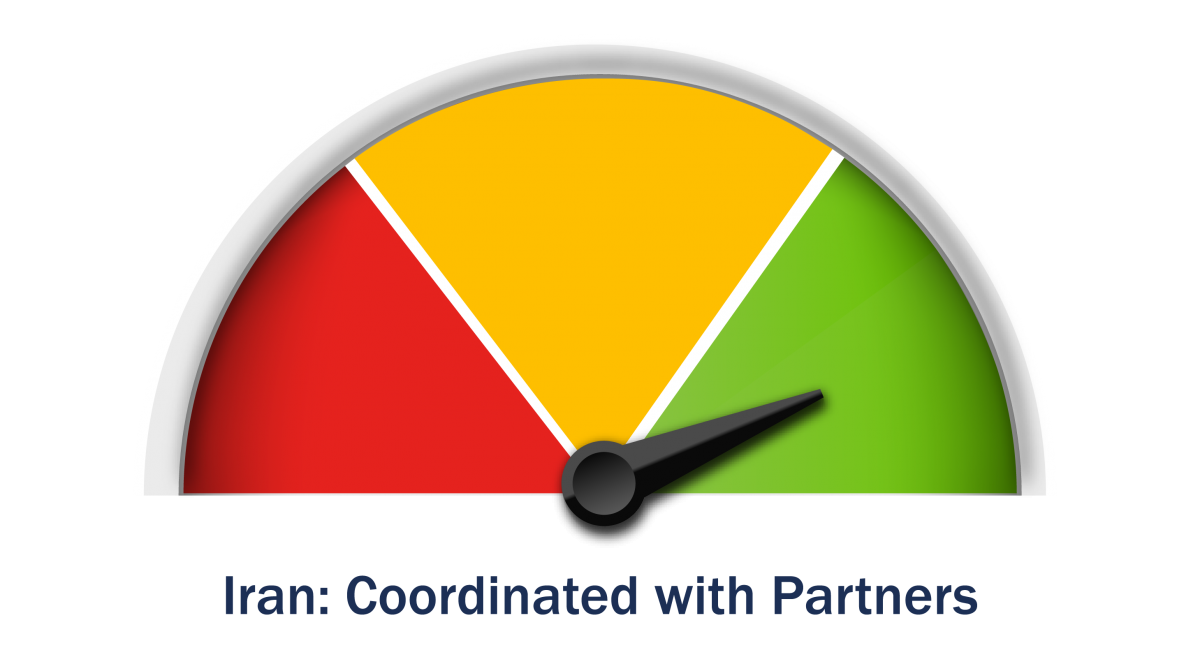 Regarding Iran’s missile program and other destabilizing activities across the Middle East, the Biden administration’s position has grown closer to that of European countries, which have consistently sustained that wrapping up the nuclear issue is the immediate priority. With some nuance in emphasis and tactics, the United States and the E3 (Britain, France, and Germany) now likely view potential conversations with Iran on regional activities as part of a lengthy, multi-year dialogue rather than any quick formal agreement.
Regarding Iran’s missile program and other destabilizing activities across the Middle East, the Biden administration’s position has grown closer to that of European countries, which have consistently sustained that wrapping up the nuclear issue is the immediate priority. With some nuance in emphasis and tactics, the United States and the E3 (Britain, France, and Germany) now likely view potential conversations with Iran on regional activities as part of a lengthy, multi-year dialogue rather than any quick formal agreement.
What to Watch
As soon as the campaign for Iran’s presidential election in June fully kicks off, negotiators on both sides will have a much harder time. The election is widely expected to empower hardliners, so if Biden wants to reach an agreement with Tehran on restoring JCPOA compliance on both sides, it will have to come in the next couple of months. To further complicate things, the negotiating process will remain at constant risk of being derailed by maneuvers such as the alleged Israeli sabotage of Iran’s nuclear facility at Natanz earlier this month or any future Israeli covert activity against the country’s nuclear program.
Mediterranean: Relations with Turkey: Stabilizing a Troubled Partnership
Next to the policy reversal on Iran, bringing the troubled relationship with Turkey back on track has been among President Joe Biden’s key regional policy aims. In its first months, his administration has aimed to stabilize rather than “fix” relations with Ankara and has worked with NATO to reduce operational risks. It has tended to hold President Recep Tayyip Erdoğan at arm’s length, judging that the prevailing difficulties in the relationship are largely the product of his government’s actions. The administration has rightly focused its critique on Turkey’s purchase of the Russian S-400 air-defense system. Unlike its predecessor, the Biden administration has also been vocal about internal developments in Turkey, including the decline of political and media freedoms. And it has put the country firmly on the U.S.-EU agenda, by means of policy coordination and public displays of unity.
Coherent, Smart, Coordinated?
 In its first 100 days, the Biden administration has taken the right track with Turkey. Its approach of de-escalation acknowledges that there is currently little prospect of a fully positive reset in relations. It inherited a relationship in a deeply troubled stage at the level of values and practical policy concerns. Despite recent steps toward de-escalation between Turkey and Greece, the United States continues to be deeply concerned about the implications of Ankara’s assertive regional posture for stability in the Eastern Mediterranean. Last summer, the brinkmanship in the Aegean had reached a point where the risk of an accidental clash or a minor incident spiraling out of control had become very real. At a minimum, the core détente that has prevailed between Greece and Turkey, and in which the United States and Europe have a clear stake, could unravel—with Russia as the only clear beneficiary. With some differences of emphasis, these perspectives are fully shared by EU leaders and within NATO. Importantly, the Biden administration and the EU’s leadership have made policy toward Turkey an explicit item for transatlantic coordination. This is new, and it is the right approach to encourage a more moderate course in Ankara.
In its first 100 days, the Biden administration has taken the right track with Turkey. Its approach of de-escalation acknowledges that there is currently little prospect of a fully positive reset in relations. It inherited a relationship in a deeply troubled stage at the level of values and practical policy concerns. Despite recent steps toward de-escalation between Turkey and Greece, the United States continues to be deeply concerned about the implications of Ankara’s assertive regional posture for stability in the Eastern Mediterranean. Last summer, the brinkmanship in the Aegean had reached a point where the risk of an accidental clash or a minor incident spiraling out of control had become very real. At a minimum, the core détente that has prevailed between Greece and Turkey, and in which the United States and Europe have a clear stake, could unravel—with Russia as the only clear beneficiary. With some differences of emphasis, these perspectives are fully shared by EU leaders and within NATO. Importantly, the Biden administration and the EU’s leadership have made policy toward Turkey an explicit item for transatlantic coordination. This is new, and it is the right approach to encourage a more moderate course in Ankara.
What to Watch
 There are some signs that Turkey has begun to modulate its approach to some of the most neuralgic issues, most notably in its energy exploration, naval deployments, and its rhetoric in the Eastern Mediterranean. Risk management in the region is an enduring challenge, and the Eastern Mediterranean will remain a flashpoint for the foreseeable future. As Erdoğan shows himself keen on mending fences with the West, coordinating U.S. and EU terms of engagement with Turkey will be key. This includes making sure transatlantic concerns about democracy and human rights violations are not lost in pursuit of other areas of interests such as keeping Turkey at an arm’s length from Russia, finding a solution for the Syrian Kurds, or renovating the EU-Turkish refugee deal. The upgrade of the EU-Turkish Customs Union, as well as potential new U.S. and EU sanctions on Turkey, will be among the key elements to watch in the coming 100 days, alongside the repercussions of President Biden’s ground-breaking description of the 1915 massacre of Armenians by the Ottoman administration as genocide.
There are some signs that Turkey has begun to modulate its approach to some of the most neuralgic issues, most notably in its energy exploration, naval deployments, and its rhetoric in the Eastern Mediterranean. Risk management in the region is an enduring challenge, and the Eastern Mediterranean will remain a flashpoint for the foreseeable future. As Erdoğan shows himself keen on mending fences with the West, coordinating U.S. and EU terms of engagement with Turkey will be key. This includes making sure transatlantic concerns about democracy and human rights violations are not lost in pursuit of other areas of interests such as keeping Turkey at an arm’s length from Russia, finding a solution for the Syrian Kurds, or renovating the EU-Turkish refugee deal. The upgrade of the EU-Turkish Customs Union, as well as potential new U.S. and EU sanctions on Turkey, will be among the key elements to watch in the coming 100 days, alongside the repercussions of President Biden’s ground-breaking description of the 1915 massacre of Armenians by the Ottoman administration as genocide.
Tech—A Down Payment on Digital Leadership
 President Joe Biden’s first 100 days have put reinvesting in U.S. technological leadership at the heart of his plans to Build Back Better. His administration’s stimulus act (the American Rescue Plan) and infrastructure bill (the American Jobs Plan) include significant investments in expanding broadband connectivity and advancing critical technology. Importantly, the administration has emphasized its intent to work closely with democratic allies to outcompete China on technology and establish rules of the road that are grounded in liberal values.
President Joe Biden’s first 100 days have put reinvesting in U.S. technological leadership at the heart of his plans to Build Back Better. His administration’s stimulus act (the American Rescue Plan) and infrastructure bill (the American Jobs Plan) include significant investments in expanding broadband connectivity and advancing critical technology. Importantly, the administration has emphasized its intent to work closely with democratic allies to outcompete China on technology and establish rules of the road that are grounded in liberal values.
Coherent, Smart, Coordinated?
A great deal remains to be done, much of which will depend on Congress and the cooperation of allies, but the Biden administration is off to a strong start in advancing a forward-looking tech agenda.
Those without a reliable broadband connection are at a tremendous disadvantage. Biden’s infrastructure plan includes a $100 billion investment in expanding access to broadband to reach people in cities, rural areas, and tribal lands who have been left behind. The bill also includes $100 billion to upgrade schools around the country, on top of the $123 billion included in the American Rescue Plan dedicated to helping schools reopen this year; both sums would help bring U.S. public schools into the digital age and bridge the digital divide.
Governments can take risks that private-sector companies cannot with early-stage investments in scientific research and foundational technology that might not yield a profit for many years. Yet the United States is one of the few major economies whose public investments in R&D have declined in recent years. The infrastructure plan designates $180 billion for research and development in areas ranging from biotechnology to advanced computing to green tech.
The infrastructure bill designates another $300 billion to bolster domestic manufacturing and secure high-tech supply chains. This was also a focus of an executive order issued in February that aims to improve the resilience of supply chains for several critical products. The infrastructure bill and the executive order each include a particular focus on semiconductors, which are in short supply globally. While this problem has no quick or easy solution, the infrastructure bill will support domestic innovation and manufacturing capacity for cutting-edge semiconductors to help create a longer-term solution to the problem.

The United States cannot rely only on technology developed and produced domestically. Ensuring the future supply of capital-intensive, heavily traded goods like semiconductors will require collaboration with allies. The executive order recognizes this interdependence, calling for “close cooperation on resilient supply chains with allies and partners who share our values.”
The United States will also need to develop rules to mitigate the risks that come with a digital world. Secretary of State Antony Blinken said last month: “We’re going to bring our friends and partners together to shape behavior around emerging technologies and establish guardrails against misuse.” These words are a strong sign that the administration will work with allies to develop rules that address digital challenges to civil and human rights, national security, and democratic discourse.
What to Watch
The Biden administration and Congress must address the United States’ debilitating information disorder, pass a federal privacy law, translate ethical principles for artificial intelligence into policy, mitigate the risks of facial recognition technology, and take on a host of other challenges. Blinken’s words suggest that the administration is up for the task and will work closely with partners to establish durable and effective rules of the road. The Biden administration has its work cut out for it, but these first 100 days are a promising start.
Economic Policy – The Great U.S. Fiscal Experiment
President Joe Biden has embarked upon a great fiscal and political experiment with the U.S. economy, the effects of which will be felt throughout the global economy. He has proposed $4 trillion (about 20 percent of GDP) in new spending since taking office. Congress has already approved the $1.9 trillion American Rescue Plan (ARP) and is debating the American Jobs Plan (AJP) infrastructure plan worth up to $300 billion annually during the next decade. The largest peacetime fiscal stimulus in U.S. history is focused on addressing poverty, inequality, and other aspects of the United States’ fraying social safety net. It implements a temporary but more comprehensive and largely debt-financed welfare state, and mimicking prior years’ “temporary” Republican tax cuts, amounts to a dare to the GOP to let it expire.
Coherent, Smart, Coordinated?
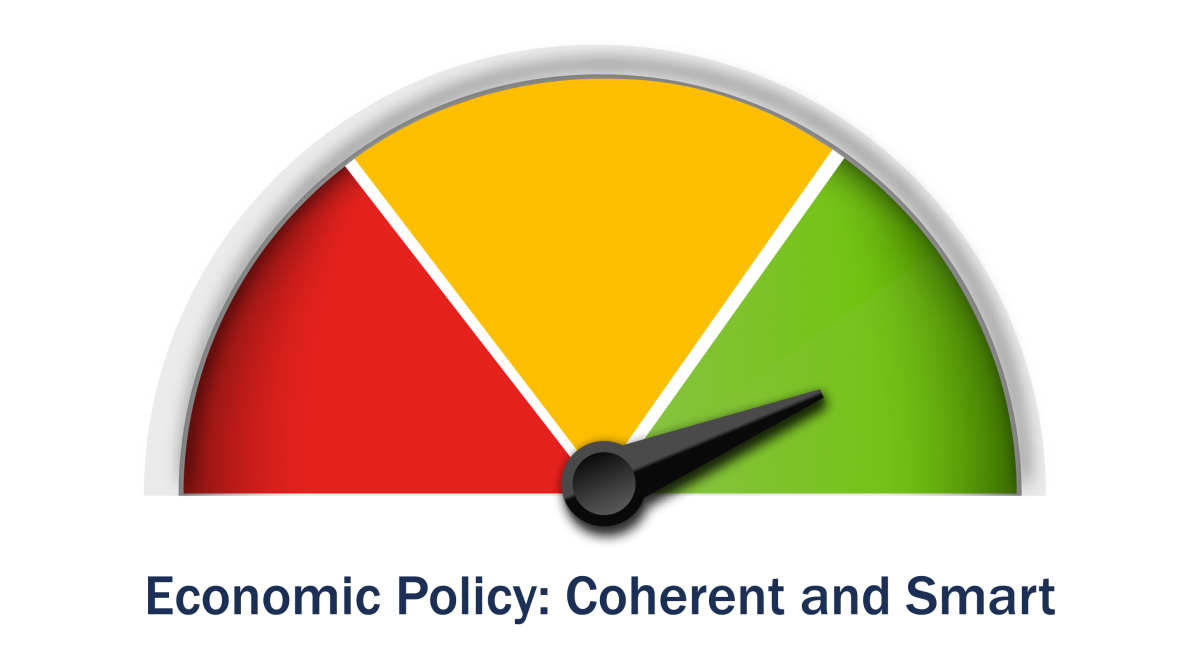 The ARP contains a very large number of targeted temporary provisions aimed at alleviating immediate financial stress though checks, expanded unemployment benefits, and poverty and education support. Meanwhile the AJP adopts an expansive definition of infrastructure, with major outlays for caretaking, affordable housing, workforce development, drinking water, and public schools and community colleges. Both are certain to have a major impact on reducing poverty and equalizing economic opportunity in the United States. And, if ultimately both are adopted, they would signify major—if often temporary—changes to the social safety net.
The ARP contains a very large number of targeted temporary provisions aimed at alleviating immediate financial stress though checks, expanded unemployment benefits, and poverty and education support. Meanwhile the AJP adopts an expansive definition of infrastructure, with major outlays for caretaking, affordable housing, workforce development, drinking water, and public schools and community colleges. Both are certain to have a major impact on reducing poverty and equalizing economic opportunity in the United States. And, if ultimately both are adopted, they would signify major—if often temporary—changes to the social safety net.
The sheer scale of the stimulus will push U.S. growth to likely at least 6 percent of GDP in 2021, well beyond the rest of the world, in all probability causing the U.S. trade and current account deficits to increase potentially quite dramatically. A deficit in manufactured goods of $1 trillion after the passage of the stimulus looks plausible, while lingering global effects of the pandemic render the traditional services trade surplus highly uncertain. Given the size of the U.S.-EU trade imbalance and the high probability that Biden will maintain trade tariffs against China, the risk of transatlantic trade friction is high.
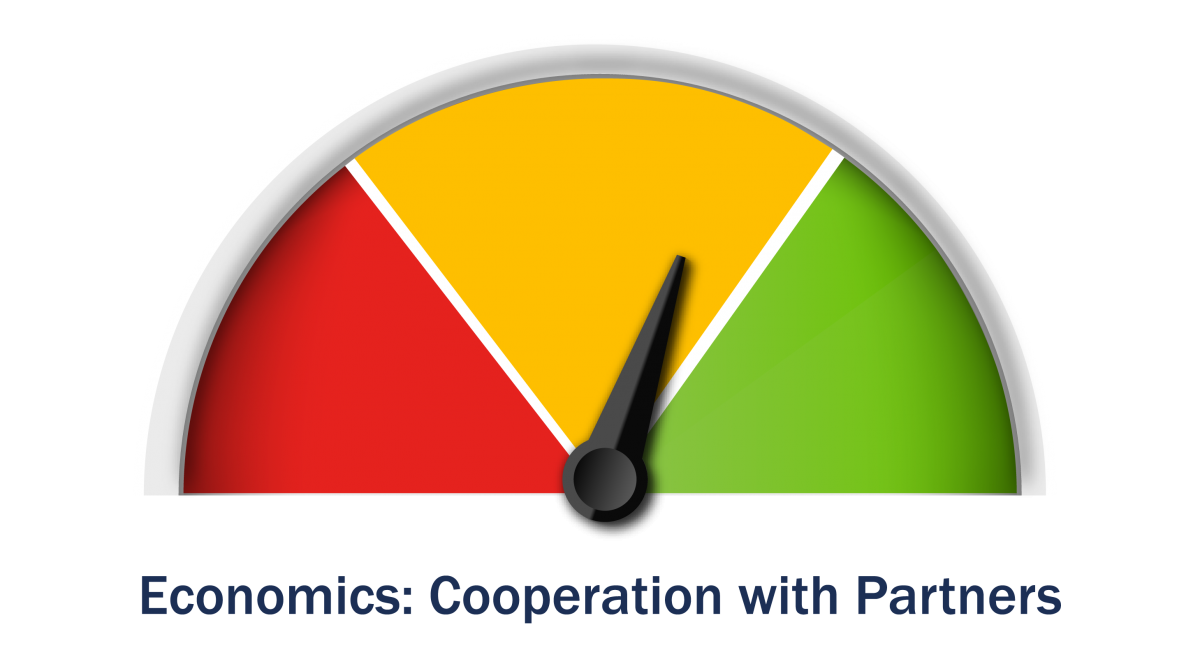 A major concern is that Biden’s fiscal stimulus could cause a rise in inflation. To a degree, this is the intention—partly to generate a politically advantageous economic boom and partly to make up for very low inflation rates since 2008. Higher inflation would compel the Federal Reserve to raise interest rates enough to cause a recession in a few years’ time. Yet, the economy remains in a deep post-pandemic hole, with 10 million jobs lost, making inflationary pressures likely transient, as the stimulus will also run out after 2023. The true inflationary challenge will emerge only if the Democrats succeed in making significant temporary spending components of the ARP permanent, but refrain from raising taxes correspondingly. Overall, the strategy is coherent and bold, even if longer-term risks are significant—for now the administration excels.
A major concern is that Biden’s fiscal stimulus could cause a rise in inflation. To a degree, this is the intention—partly to generate a politically advantageous economic boom and partly to make up for very low inflation rates since 2008. Higher inflation would compel the Federal Reserve to raise interest rates enough to cause a recession in a few years’ time. Yet, the economy remains in a deep post-pandemic hole, with 10 million jobs lost, making inflationary pressures likely transient, as the stimulus will also run out after 2023. The true inflationary challenge will emerge only if the Democrats succeed in making significant temporary spending components of the ARP permanent, but refrain from raising taxes correspondingly. Overall, the strategy is coherent and bold, even if longer-term risks are significant—for now the administration excels.
The Biden administration has proposed to partly fund the AJP with a major increase in the top income tax rate and corporate taxes. It has also suggested that the OECD members and others agree to a new global corporate tax reform, which would result in the United States accepting that companies pay taxes around the world based upon the activities in the country in question (affecting mostly major U.S. tech companies). It also advocates a 21 percent global corporate minimum tax, effectively eliminating tax shelters and low tax jurisdictions around the world. This would have large implications for many countries, not least low tax jurisdictions in the EU, and would, if comprehensively implemented, result in large multinational corporations paying significantly higher levels of tax. It would also avert a major trade war over digital services taxes imposed on U.S. tech companies by EU members and other countries around the world. On tax, the administration’s moves coordinate well with many EU allies, but it is unclear if broader trade relations will improve, so it is a pass.
What to Watch
Many sources of uncertainty remain. Congressional support for the AJP remains uncertain, while inflationary pressures in the U.S. economy will rise in the coming quarters. And, despite the support of the United States and many EU members, an agreement on a global corporate tax reform is not a given.